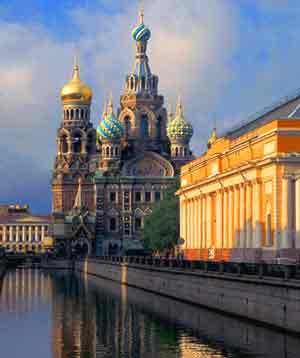 The beginning of the 19th century found Russian literature a stagnant and State-controlled pursuit. Dissident writers and radical members of the intelligentsia were usually arrested and condemned to hard labor in Siberia. Influenced by the French realism of Gustav Flaubert and Honoré de Balzac, emerging Russian authors of the mid-century found new subjects for their own stories: Peasants.
The beginning of the 19th century found Russian literature a stagnant and State-controlled pursuit. Dissident writers and radical members of the intelligentsia were usually arrested and condemned to hard labor in Siberia. Influenced by the French realism of Gustav Flaubert and Honoré de Balzac, emerging Russian authors of the mid-century found new subjects for their own stories: Peasants.
“Philanthropic novels” explored the hard lives and injustices of the serfs, the mostly lowly segment of Russian society. During his stretch in Siberia for consorting with known radicals, Fyodor Dostoevsky met hardened criminals and marginalized peasants and learned of their desperate lives and suffering first-hand. He took their stories with him when he returned to St. Petersburg in 1859.
For over a century at that time, the university in St. Petersburg drew great thinkers, artists and writers to a city already teeming with lively characters, from lunatics to lowly clerks and poor students living in garrets, eating in the city’s hotels and drinking in its barrooms. Dostoevsky observed the city’s crowds. He poured over newspapers for strange but true accounts of crime and tragedy. With these models for inspiration, he filled the 629 pages of Crime and Punishment, depending on the edition, with the story of a kopeck-less student’s descent into mumbling madness after he brutally murders and robs an old pawnbroker and her sister.
After careful planning, Rodion Romanovich Raskolnikov manages to carry out the crime without witnesses or leaving behind any evidence. Forensics being as unknown as nuclear energy in the 1860s, the only way police could catch criminals were by eyewitness testimony, blatant evidence of the crime or catching them in the act.
Raskolnikov lapses into a paranoid fever for three days after the crime. He wanders the streets of St. Petersburg and comes into contact with a cross-section of its residents: Porters, prostitutes, gentlemen, hawkers of second-hand wares and policemen. Dostoevsky had a unique talent for bringing the unwashed masses into his novels and giving them their own voices. Not only are there the main characters to speak of, there are other nameless bodies going about their business around them. Dostoevsky even wrote about the city of St. Petersburg as a character in and of itself.
“This is a town of crazy people…There are few places where there are so many gloomy, strong and queer influences on the soul of man as in Petersburg.”
During one of his more demented days, Raskolnikov is almost run over by a coach. The coachman strikes his back with a whip, sending him into a bridge railing. A few passing denizens of St. Petersburg each get a few lines of dialogue to round out Raskolnikov’s public humiliation.
“He angrily clenched and ground his teeth. He heard laughter, of course.
“Serves him right!”
“A pickpocket I dare say.”
“Pretending to be drunk, for sure, and getting under the wheels on purpose; and you have to answer for him.”
“It’s a regular profession, that’s what it is.””
During his lunacy, he meets his sister’s new fiancé, Pyotr Petrovich Luzhin. He verbally abuses the man for being a skinflint and threatens him with grievous bodily harm until Luzhin flees from the tiny room. Raskolnikov’s nervous condition lifts by the time his mother and sister arrive in St. Petersburg, but his erratic behavior raises some eyebrows at dinner. His friend, Razumihin, takes care of him during the delirium and shows a great devotion to him, even while Raskolnikov hurls insults at his head. His mother and sister also take the abuse without question, which led me to believe that his personality had suffered a sea change leading up to the murder.
His strange behavior also draws the attention of Porfiry Petrovich, a detective working on the murder investigation, who otherwise had no reason to suspect him. Raskolnikov even goes so far as to explain to another detective, Zametov, how a person would carry out such a murder, just short of telling the detective that he is the guilty party. At times, Raskolnikov’s obsessive thoughts about the crime reminded me of Edgar Allen Poe’s “The Tell-Tale Heart”; his guilt and increasing paranoia would eventually cause him to confess and accept punishment.
Crime and Punishment‘s secondary plot centers on the Marmeladov family. Raskolnikov meets the patriarch at a bar. Once a government clerk, Marmeladov is now a drunkard while his family pays the price. His wife suffers from consumption; her children wear rags and often go to bed hungry. Marmeladov’s daughter, Sofya Semyonovna, has to prostitute herself in order to provide food and rent money. Yet, the squalid state of his family is not enough to convince Marmeladov to sober up or get a job.
A third plot line involves a love square among Raskolnikov’s sister, her fiancé, her former employer, and Razumihin. A few hundred pages of back-story explain that one.
Through his novels, Notes From Underground and Crime and Punishment, Dostoevsky broke new ground in the Russian Realism School of writing prevalent in the 1860s. Instead of focusing entirely on the daily lives of Russia’s peasants or landed gentry, he took the narrative a step further to present and analyze the thought processes of his characters. Though long and incredibly wordy, Crime and Punishment makes for an interesting read, especially for the innovative point of view, raving lunacy or not.
Rating: 4 of 5








